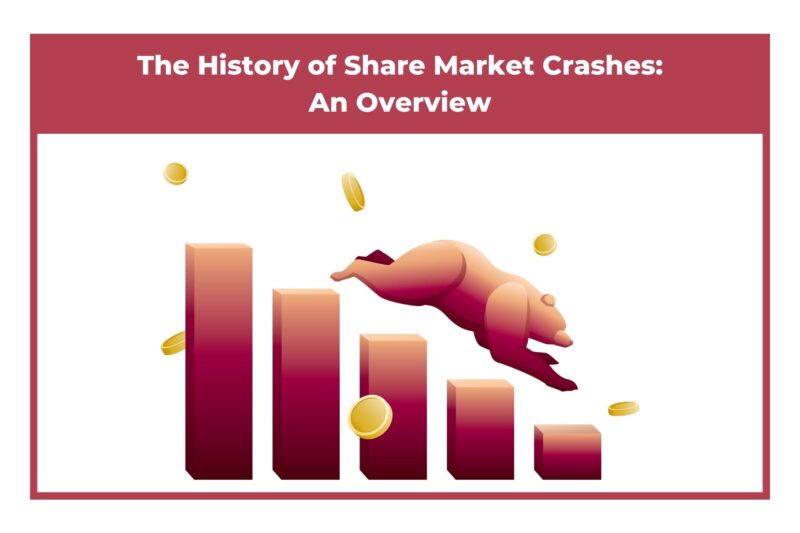Delve into the past with an insightful historical overview of share market crashes. Gain valuable insights into the causes, effects, and lessons learned from these significant financial events.
Market crashes don’t happen very often – in fact, they usually occur every few decades. They tend to happen as a result of some unusual circumstance that throws the market off its balance for a short period. These unusual circumstances are generally related to negative news about companies with large market capitalization or an entire industry. A crash is made worse by some other factors like over-leveraging by investors or illiquid markets that make it hard for sellers to exit their positions without taking losses. Let’s take a look at some famous crashes in the history of the stock market:
The Great Depression of the 1930s
The Great Depression is remembered as the most widespread and longest-lasting economic crisis of the 20th century. While the stock market crash of 1929 is frequently cited as the start of the Great Depression, most economists tie the start of the downturn to the monetary contraction of 1930–31, which resulted from fears of government budget deficits and a decline in the gold standard. The Dow Jones Industrial Average fell 29% from October 1929 to July 1932, when it bottomed out at 41.22 (it was actually above 100 as late as mid-1929). Though it would mount a partial recovery during the 1930s, and even exceed its 1929 high for a few months in 1933, the Dow would remain below its 1929 high for the next 45 years. Out of all the market crashes listed here, this one was the worst. While most of the others might have been bad, they weren’t as bad as the Great Depression.
1987 Stock Market Crash
The 1987 stock market crash occurred when stocks fell 20%–50% in a few days as a result of a combination of factors. These included program trading on the New York Stock Exchange, portfolio insurance, and the buying and selling of portfolio insurance. The Dow Jones Industrial Average lost 22.6% on October 19 alone, its largest one-day percentage drop in history. The S&P 500 lost 22.8% on October 19, the most on any single day in history as of 2019. The crash had significant financial and geopolitical consequences.
Dot-com crash in 2000
The dot-com bubble was a period of excessive investment in Internet-based companies that began in 1995 and ended in 2000. The NASDAQ Composite stock market index peaked on March 10, 2000, at 5048.62 and hit its trough on October 9, 2002, at 10,410. The NASDAQ more than tripled from February 1996 to March 2000. The reasons for the collapse are debated, but some commentators have blamed the release of too much equity at once by companies. Investors may have been too optimistic about the future profits of new Internet-based companies. When the bubble burst, companies that had borrowed money to finance their growth couldn’t repay their debts, and investors lost billions of dollars in paper wealth.
2008 Financial Crisis
The financial crisis of 2007–2008 was a financial crisis that involved the collapsing mortgage-backed security (MBS) market and the subsequent deleveraging of the balance sheets of financial institutions. The crisis was triggered by a liquidity shortfall in the inter-bank lending market and the collapse of the investment bank Lehman Brothers, which triggered the credit default swap (CDS) insurance crisis. This was followed by a significant reduction in the availability of credit (debt financing) caused by a general global decline in confidence as well as the effects of the housing market correction. The Dow Jones Industrial Average lost 29.32%, or 802.48 points (29,032.80), closing at 10,877.44 on November 3, 2008, its largest point loss in absolute terms in the index’s history, after having lost 9.9% the week before.
2016 Brexit Surprise
The Brexit vote on June 23, 2016, followed by the British government’s decision to leave the European Union, was a surprise event that led to a sudden drop in global equity markets. The effects of the vote on the markets were so strong that it was dubbed the Brexit crash. The Dow Jones Industrial Average lost 5.5% on June 24, its biggest daily point loss since the day after the September 11 attacks in 2001. The FTSE 100 fell 10% in one day, and the pound sterling fell to its lowest level against the U.S. dollar since 1985.
Summary
The Great Depression of the 1930s was the worst stock market crash in the history of the stock market. The dot-com crash in 2000 and the financial crisis of 2008 were two other major crashes, but the Brexit surprise of 2016 was the most recent. Many things can cause a crash, but the important thing is to be prepared for them. Start saving early, and build up an emergency fund. You never know when the market may fall.


